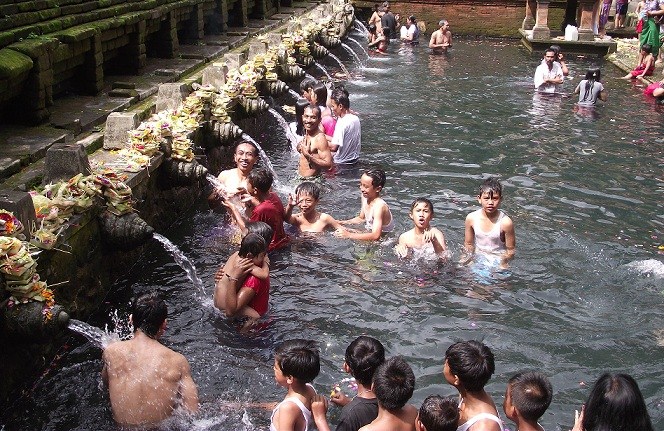 |
Candi Kudus Musim Semi |
Musim semi Kudus
Apa yang Anda akan lihat adalah musim semi megah di Hindu candi. Terus air merembes dari mata air di putar cara, menampilkan pemandangan luar biasa. Kemudian air dikumpulkan dan diarahkan ke kolam lain di mana orang-orang beriman mengambil Kudus mandi
Sejarah geologi Bali dan daerah lainnya di Indonesia adalah kompleks. semua pulau-pulau, termasuk Bali, yang relatif muda, pulau paling awal tanggal dari akhir Miosen, 15 juta tahun yang lalu.
Secara geologis Bali masih aktif dengan dua gunung berapi aktif utama pusat, Mt. Agung dan Gunung Batur yang kompleks, yang meletus di rata-rata sekali setiap tujuh tahun.
Indonesia adalah kepulauan vulkanik yang sangat panas dan akibatnya telah mata air di semua tempat, tetapi sedikit yang dikembangkan atau jejak wisata. Bali adalah tujuan paling populer musim semi panas oleh satu mil, tetapi banyak dari mereka yang dianggap suci dan telah berkembang menjadi kuil, di mana penduduk lokal datang untuk mandi (sepenuhnya pakaian) tetapi orang asing mungkin tidak diterima. Beberapa, bagaimanapun, telah telah dikembangkan dan terbuka untuk semua. Berikut batu ukiran mulut memungkinkan air panas untuk melewati antara kolam yang diatur di antara rimbun taman.
Sumber panas
In active zona vulkanik seperti Bali, air dapat dipanaskan dengan datang ke dalam kontak dengan magma (batuan cair). Gradien suhu tinggi magma dekat dapat menyebabkan air harus dipanaskan cukup bahwa itu bisul atau menjadi panas. Jika air menjadi begitu panas sehingga membangun uap tekanan dan meletus dalam jet di atas permukaan Bumi, itu disebut geyser. Jika air hanya mencapai permukaan dalam bentuk uap, itu disebut suatu fumarole. Jika air dicampur dengan lumpur dan tanah liat, itu disebut pot lumpur. Jika air dicampur dengan mata air dingin hasilnya itu Hangat musim semi.
Sumber: “;The full Wiki”;
dan mengetahui hal ini, untuk login Anda menemukan Anda harus mengirimkan saya mail menjelaskan, bahkan jika sebentar :
1 - Apa jenis musim semi yang kita lihat di sini?
1 - Mengapa suhu musim semi ini bervariasi dari hangat menjadi sangat panas?
3 - Apa yang tertulis dalam plakat yang ada di GZ?
Anda dapat melihatnya di gambar plakat . Saya tidak bisa meminta Anda untuk foto di musim semi namun akan lebih bagus jika Anda bisa menambahkan beberapa ke log.
The Holy Bath

 |
Holy Spring Temple
|
The Holy spring
What you are going to see is a magnificent spring in a Hindu temple. Continuously the water oozes from the spring in a revolving manner, displaying a superb sight. Then the water is collected and directed to other ponds where the believers take the Holy Bath
The geological history of Bali and the other regions in Indonesia is complex. All the islands, including Bali, are relatively young, the earliest island dates from the end of the Miocene, 15 million years ago.
Geologically Bali is still active with two main active volcanic centres, the Mt. Agung and Mount Batur complex, which erupt on average once every seven years.
Indonesia is a highly volcanic archipelago and consequently has hot springs (air panas) all over the place, but few are developed or on the tourist trail. Bali is the most popular hot spring destination by a mile, but many of them are considered holy and have been developed into temples, where the locals come to bathe (fully clothed) but foreigners may not be welcome. A few, however, have been developed and are open to all. Here stone mouth carvings allow hot water to pass between pools which are set among a lush garden.
Sources of heat
In active volcanic zones such as Bali, water may be heated by coming into contact with magma (molten rock). The high temperature gradient near magma may cause water to be heated enough that it boils or becomes superheated. If the water becomes so hot that it builds steam pressure and erupts in a jet above the surface of the Earth, it is called a geyser. If the water only reaches the surface in the form of steam, it is called a fumarole. If the water is mixed with mud and clay, it is called a mud pot. If the water is mixed with cold springs the result it’s a Warm spring.
Source: “The full Wiki”
And knowing this, to log your found you have to send me a mail explaining, even if briefly:
1 - What kind of spring we are seeing here?
1 - Why the temperature of this spring varies from warm to very hot?
3 - What is written in the placard existent at the GZ?
You can see it in the Image Placard . I can't ask you for a photo at the spring but it would be great if you could add some to the log.


Free counters